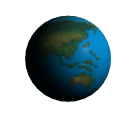Structure of the Earth
Have you ever wondered
what the planet Earth is made
of? Think of a boiled egg.
An egg constitutes the thin shell,
the white and the yellow yolk in the middle. Like wise the earth is
made up of the thin outermost layer called the crust, the innermost part called the core,
and the part in between them called the mantle.

At the start, the early earth seemed to have heated up. The centre became molten, and convection currents developed. The lighter materials floated towards the surface forming the brittle crust. The crust is very thin approximately 40Km or so thick. Together with the top part of the mantle, it formed the hard slabs known as lithosphere. The continents are set in these slabs. The lithosphere is divided into 2 parts, the oceanic (Sima) and continental crusts (Sial).
Sima , the floor of the deep oceans, is about 8Km thick and is composed of relatively dense rocks like basalt. Sial, however, is much thicker, averaging 32Km, and is made up of relatively light material, for example granite.
The denser materials such as iron and nickel sank to form the core. The coreis made up of two parts, the inner and outer core. The inner core is solid, made up of iron and nickel. This is where the Earth's magnetic field originates. The outer core is liquid and it is extremely hot, about 3000ºC.
Between the core and the crust, the intermediate zone forms the mantle. This is liquid but very viscous and is made up of molten rocks, called the magma.
Radioactive decay in the inner core creates all the heat inside the Earth. This heat causes the convection currents which cause the plates of the crust to move.
Continue... Continental Drift
Tags:Earth structure, Mantle, Crust, Core, Convection currents